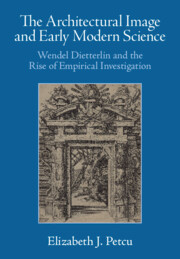 The Architectural Image and Early Modern Science
The Architectural Image and Early Modern Science Book contents
- The Architectural Image and Early Modern Science
- Reviews
- The Architectural Image and Early Modern Science
- Copyright page
- Dedication
- Contents
- Editorial Note
- Acknowledgements
- Introduction The Renaissance of Architecture as Art and Science
- One Architecture’s Figural Turn
- Two Devising the Architectura: Rationalism and Empiricism in Architectural Design
- Three Drafting the Architectura: Drawing as Research in Art, Architecture, and Science
- Four Printing the Architectura: Architectural Etching Becomes Alchemical Inquiry
- Five Dissecting the Architectura: Anatomy, Ornament, and the Limits of Figuration
- Six Deconstructing the Architectura: Enduring Matter and Transient Forms in Peru
- Conclusion The Death and the Life of the Architectural Image
- Select Bibliography
- Index
Three - Drafting the Architectura: Drawing as Research in Art, Architecture, and Science
Published online by Cambridge University Press: 29 November 2024
- The Architectural Image and Early Modern Science
- Reviews
- The Architectural Image and Early Modern Science
- Copyright page
- Dedication
- Contents
- Editorial Note
- Acknowledgements
- Introduction The Renaissance of Architecture as Art and Science
- One Architecture’s Figural Turn
- Two Devising the Architectura: Rationalism and Empiricism in Architectural Design
- Three Drafting the Architectura: Drawing as Research in Art, Architecture, and Science
- Four Printing the Architectura: Architectural Etching Becomes Alchemical Inquiry
- Five Dissecting the Architectura: Anatomy, Ornament, and the Limits of Figuration
- Six Deconstructing the Architectura: Enduring Matter and Transient Forms in Peru
- Conclusion The Death and the Life of the Architectural Image
- Select Bibliography
- Index
Summary
If Dietterlin’s Architectura epitomized the empirical turn in architectural image-making, the preparatory drawings for the treatise’s etchings show how such firsthand research in art, architecture, and science coalesced in drawing as a context for managing visual research. The 164 surviving Architectura drawings constitute an ideal case study for this phenomenon, for they stand as one of the largest corpora of sixteenth-century architectural drawings made north of the Alps. Dietterlin’s Architectura drawings are compared with drawings from Bramante and Raphael’s St. Peter’s workshop as well as botanical and geological drawings by natural historians Conrad Gessner, Ulisse Aldrovandi, and other natural philosophers. The comparison reveals that, during the sixteenth century, tactics for making images and managing information – such as cutting, collaging, annotation, folding and counterproofing – came to inform both architectural and scientific drawing. Indeed, artists, architects, printers, and natural philosophers began to trade tactics of drawing as a means for managing visual information, thereby codeveloping empirical artistic techniques for producing knowledge. Through its drawings, Dietterlin’s Architectura promoted the new, empirical methodology of architectural image-making.
Keywords
- Type
- Chapter
- Information
- The Architectural Image and Early Modern ScienceWendel Dietterlin and the Rise of Empirical Investigation, pp. 169 - 238Publisher: Cambridge University PressPrint publication year: 2024
